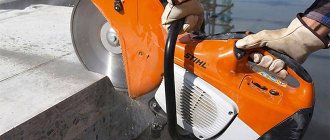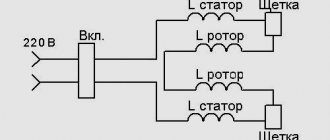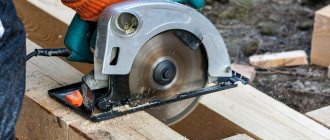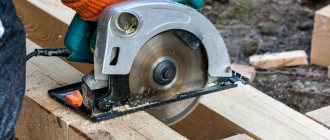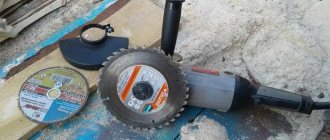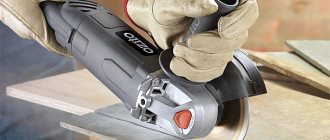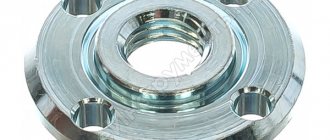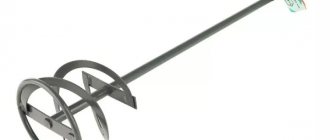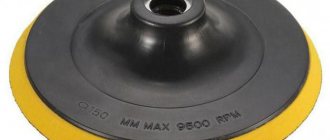Description and classification
A diamond disk is a metal circle of small thickness with cutting diamond plates fixed on the edges. They are made from industrial ground diamonds, which are pressed into a metallic binder - carbide, steel or titanium. The plates are attached to the disks using silver soldering or laser welding. Modern technologies connect the cutting tool to a metal base using powder soldering. This way they last longer. Once the cutting part of the diamond blade has been sharpened, it is completely ready for use.
In order to cut reinforced concrete or concrete, a variety of equipment is used, such as stationary machines, wall chasers, gas cutters, and grinders. Different brands of circles are attached to them. Their distinctive features are:
- Working edge configuration.
- Composition of the binder.
- Number of diamonds per unit area.
- Quality indicators of diamonds.
To choose the most suitable option for you, you need to familiarize yourself with the classification.
Circles are divided into groups according to several criteria. The most important indicators are: the purpose and shape of the cutting part.
Diamond cutting discs
This group is divided into three subspecies. These include:
- Segmental for dry cutting. Concrete is cut dry using hand tools. For these purposes, a grinder (angle grinder) and a wall chaser are used. On the base of the segmented circle, the diamond contour is located in the form of separate sectors, and between them there are radial through grooves. During the cutting process, the plates experience heavy loads and the discs heat up. The slots are necessary to relieve stress in the cutters, remove waste, remove heat and compensate for linear expansion. This group includes diamond tools for cutting fresh concrete. The difference between such circles is that they can be used to cut material immediately after hardening. The diamond layer is usually filled directly onto the body without using a binder.
- Infinite (whole). There are no segments on such circles. And in order to distribute the tension, there are holes. They are used when cutting is carried out with water cooling. Wet processing is carried out on stationary equipment. Such equipment has the design ability to supply coolant.
- Diamond discs for reinforced concrete. These discs have a segmented design, but the teeth contain more diamonds than a conventional disc type. They are a little thicker. It is necessary to take into account the fact that reinforced concrete is very difficult to cut at home. The grinder heats up quickly, dust penetrates inside it (to prevent dust from penetrating, dust protection for the bearings and a dust-proof motor are necessary). Using a hand-held power tool, it will be possible to cut reinforced concrete no deeper than 10 centimeters in one go. After this, the equipment will turn off to cool the disk and motor.
- Turbo segment diamond cutting wheels. They are solid, and their cooling is carried out due to the wavy surface. Their price is higher than regular circles, but they compensate for these costs with expanded functionality and a long service life. They can even cut reinforced concrete if the diameter of the reinforcement does not exceed 10 centimeters.
Diamond grinding discs
These wheels are used to grind concrete if it is necessary to level the floor before applying a decorative coating. This process is carried out with a special grinder or grinder. Grinding wheels differ in that the cutting diamond layer is applied to a conical annular surface that protrudes along the edge. A diamond disk for mechanical floor processing is a main circle on which several grinding cups are attached, between which there are grooves for removing dust.
Diamond blade - what is it?
For the manufacture of diamond discs, high-strength hardened steel is used that is resistant to various temperatures. The cutting element of the circle is a diamond coating in the form of chips, which is located on its outer edge and is made as a solid segment. When cutting concrete and other materials, the diamond chips begin to wear off, and therefore the wheel itself gradually wears down. Of course, diamond discs grind down very slowly, because after erasing one diamond layer, another working layer appears on the surface of the disc, which significantly extends the operating time of an expensive grinding wheel.
Grinder and grinding disc
Why grind a concrete floor?
Recently, technologically advanced pouring and installation of a concrete floor for laying floor coverings cannot be imagined without grinding. High-quality work will make the coating practical. It will reduce the cost of money and effort on leveling the floor surface, installing parquet or laminate, and does not require periodic restoration.
The cup attachment is used for preliminary preparation of the base for laying new floor coverings
In addition, it provides the following capabilities:
- use concrete pavement in shops and warehouses without finishing floor material;
- will increase strength to mechanical loads and abrasion;
- will increase the water resistance of the coating and will not allow chemicals to corrode the structure;
- Gives a shiny look that can be used in any interior.
Attention! If a fresh coating is being sanded, then additional steps related to the removal of lime milk are not performed. When sanding an old floor, the old layer is removed.
Grinding is used to provide a flat and smooth surface for treatment with strengthening compounds or coating with paints. In this case, grinding is done on the new coating in two stages:
- After 3-5 days after pouring - pre-treatment.
- After complete hardening of the composition - final processing.
Using a tool with a special disc attachment for grinding concrete on a grinder will solve a number of problems in cleaning and eliminating minor defects:
- Cracks.
- Chips.
- Surges.
- Ripple.
- Notches.
Sanding is used to restore the coating. Especially when leveling work is carried out on an old floor. The first step is to remove the worn layer, and then use an angle grinder. If this is not done, the strength of the leveling layer will decrease.
Various cup shapes for angle grinder equipment
An unpolished concrete floor absorbs moisture in large quantities. If the coating is located outdoors or in an unheated room, then at subzero temperatures the concrete will freeze, and the moisture in it will increase in volume, which may cause cracks.
Why are grinding discs needed?
When concrete hardens, larger components sink lower, and so-called cement laitance remains on the surface. As a result, a lot of dust forms on the hardened concrete, and the concrete surface itself, due to the large number of microcracks, resembles dried out earth. That is why grinding is needed, which eliminates all defects on the concrete base. This operation is performed with special diamond discs.
As practice shows, diamonds, compared to other materials, have higher abrasive abilities and a longer service life. The efficiency of a disk is determined by the quality and speed of processing. These parameters largely depend on the grain size of the disc. Depending on the required level of grinding, a diamond grinding disc for concrete with different concentrations of diamond chips is used.
Sometimes diamond wheels with a sprayed coating of carbide materials are called diamond.
Grinding discs with a high diamond content are used, as a rule, in the preliminary stages of concrete grinding, and with a low concentration - during polishing. For most grinding jobs, medium-concentration discs are used.
Which nozzle to choose?
In order to process the coating efficiently, you need to carry out the work slowly, taking into account the nuances. When choosing a nozzle, take into account the type of concrete and the fillers it contains. There should be no holes or bumps on the floor more than 5 mm high.
Abrasive cup attachment for angle grinders
The cost of the work depends on the choice of material on the disk-cup, and the material is selected based on the purpose of the room.
- The best option is a disk-cup with crushed stone metamorphic small fractions.
- If impregnation is applied on top, then use marble or granite chips.
The disc must contain small fractions of strong rocks that will polish the surface of the concrete. They are easy to work with, but more difficult with a disc made of sedimentary gravel. The quality of processing depends on the density of the filler. High density is not recommended, and low density will not allow you to achieve quality.
Standard sizes
Concrete grinding disc 125 is a circle of metal onto which cutting parts (segments) are soldered. To fix the diamond powder on the segments, a special binder is used - a substance that connects the individual grains together. This bond may be ceramic, metallic or organic. The main task of the bond is to hold the diamond coating, which is subject to the centrifugal force that occurs when the tool rotates. Diffusion sintering is used to connect the diamond layer to the metal body.
The drive designation contains three parameters:
- disk diameter, mm;
- cutting width (working fluid thickness), mm:
- bore diameter, mm.
For example, the designation of the HILTI DC-D 125/22 UP disk is deciphered as follows: 125 is the diameter of the circle, 22 is the diameter of the mounting hole. In this case, the width of the cut is not specified. This means that it is minimal. Mentioning cutting width is usually a marketing ploy. The manufacturer wants to emphasize that his tool is wider and, therefore, stronger. But, in fact, this does not correspond to reality.
Criterias of choice
It can be quite difficult for non-professionals to choose the appropriate grinding tool for their current tasks. To correctly solve this problem, you need to take into account:
- type of material being processed;
- planned grinding depth;
- parameters of the disk itself: number of segments, diameter, rotation speed.
For private construction, concrete grinding disc 125 is most often used, the price of which varies over a fairly wide range and depends mainly on the manufacturer.
Discs with a diameter of 125 are designed for the simplest and most low-power home angle grinders
Dimensions
Dimensions are regulated according to GOST 10110–87:
- The thickness of the diamond layer is 5 or 10 millimeters and is measured in the radial direction.
- Height. The thickness of the disc body ranges from 0.15 to 2.4 millimeters.
- Seat (inner diameter). The standard value varies from 12 to 76 millimeters. For cutting reinforced or ordinary concrete, a circle with a seat of 20 millimeters is more suitable than others.
- The outer diameter ranges from 50 to 500 millimeters. The step between adjacent cuts in the range of 50-200 millimeters is 25 millimeters, and in the range of 200-500 the step is 50 millimeters. Typically, concrete is processed with circles with a diameter of 115–500 millimeters.
The ratio of dimensions, which are approved by GOST, ensures reliability and strength.
But it is stipulated that the circles can have a height and internal diameter that are not included in the standard size range. Particularly popular these days are products with a seat size of 22.2 millimeters, as well as 25.4. There are hard and soft discs depending on the hardness of the binding material. Soft ones are intended for hard materials (reinforced concrete and concrete). They have a relatively small resource, but cutting is carried out much faster. Hard ones are intended for soft materials such as asphalt, fireclay, clinker, marble.
Price
Approximate prices of diamond blades from different manufacturers:
| Disc diameter, mm | Manufacturer | Cost, rub |
| 115 | Luga Nova | 90-120 |
| Hilti | 280-340 | |
| Bosch | 480-620 | |
| 125 | Luga Nova | 90-195 |
| Hilti | 280-400 | |
| Bosch | 750-1200 | |
| 150 | Luga Nova | 90-220 |
| Hilti | 450-550 | |
| Bosch | 840-1200 | |
| 200 | Luga Nova | 280-350 |
| Hilti | 450-700 | |
| Bosch | 900-1400 | |
| 230 | Luga Nova | 300-400 |
| Hilti | 650-840 | |
| Bosch | 1400-2700 | |
| 250 | Luga Nova | 450-800 |
| Hilti | 1250-2900 | |
| Bosch | 3500 |
The advantage of diamond blades is their wear resistance and strength, as well as the accuracy and high quality of the cut. When using this tool, chips and burrs do not form, even when processing such a durable and porous material as concrete.
Shape and number of segments
The quality of the work performed depends on the type and number of segments. There are cups for roughing, rough grinding and for fine polishing of surfaces. According to the shape of the cutters, the nozzles are classified into the following types:
- With double segment
- Square
- Boomerang
- Turbo
- Typhoon
The design of each type provides for a specific arrangement of segments, which affects its operating properties.
Boomerang
The tool received its name due to the similarity of the shape of the diamond segments to a boomerang. The tool is used for finishing concrete grinding, since the cutters use fine-grained diamond chips. After processing, the screed becomes perfectly smooth.
The small weight of the “Boomerang” makes it easy to use; it is often installed on an angle grinder because it is light in weight. The popularity of this type of cup is due to its high productivity, which is almost twice that of other types of diamond blades. The choice of this particular tool is also influenced by its lightness and stability.
Square
Diamond cups “Square” are used for roughening concrete surfaces. The effectiveness of the tool allows it to be used to remove large sagging and protruding seams. Diamond cutters are made in the form of squares. The increased thickness of the working segments and the large distance between them make it possible not only to level the surface with roughness, but also to remove any protruding parts on the concrete. Therefore, grinding with the “Square” attachment reduces the time for rough processing of concrete and brick coatings, extending the life of the diamond segments.
“Square” have a lot of weight, making it possible to process the material with a tool without much effort.
After passing through the diamond cup, the surface remains rough, which gives it high adhesive properties.
This is especially important for adhesion to applied coatings, especially polymer ones
Turbo and Typhoon
The diamond cutters of these attachments are located in a circle on the working surface perpendicular to the direction of rotation. The minimum distance between them creates an almost continuous ring. The appearance of “Turbo” and “Typhoon” disks resembles corrugated fabric. Many segments smoothly polish the surface, so the products are used for finishing grinding on small areas and for shaped stone processing. Using attachments, you can chamfer and form edges, as well as polish small curves on workpieces.
To perform small operations, you can purchase “Turbo” and “Typhoon” cups of small diameter – from 100 mm. The discs are characterized by wear resistance, high productivity and precision processing.
Wood processing
For those who build wooden houses, repair or manufacture wooden furniture, it is important to be able to properly process wooden products. First of all, decide on the necessary tool. The most common and affordable is an angle grinder (angle grinder) or, as it is also called, an angle grinder. This tool is available in every home. With its help, you can perform almost all wood processing work: sanding logs, leveling, sanding and polishing.
Grinder attachments for wood
First of all, you need to know which attachments are used for a particular operation.
- To perform rough preparation of logs during the construction of a log house, a disk plane is used. When working with such an attachment, the tool should be held with both hands. Sometimes workers remove the cover, but then it is necessary to protect the face from flying chips.
- The stripping disc is designed for removing bark from logs. If necessary, they can be used to saw lumber. In this case, the disadvantage is a wide cut and a large amount of sawdust.
- Finishing is used when grinding of a log house is needed. In this case, discs with abrasive are used.
- Brushes are used when it is necessary to level the surface.
- End discs are used when processing ends, corners or oblique cuts.
- If grinding wood with a grinder is necessary, sanding floors, processing ends and edges, preparing the surface before painting, use flap attachments and grinding wheels.
- To sand boards with a grinder, use wheels made of fine-grained sandpaper, felt or other material.
These are the main, but not all, attachments used for angle grinders. In order to sand wood with a grinder, you need to know the basic techniques. Cleaning of the log house is done using end attachments. The device should be held at a slight angle. This attachment is easy to clean not only corners and joints, but can also effectively clean logs. The timber is sanded in the same way.
Using angle grinders to artificially age wood
Nowadays, wood processing is very popular, allowing it to be artificially aged. This technique is called brushing.
The work is done with an angle grinder using a special set of attachments.
When performing such an operation, the device should be moved along the fibers.
First, a steel-bristle nozzle is used. It selectively removes fibers, roughing the timber. Before painting, the workpieces are finished polished using devices with copper or sisal bristles. Sometimes a universal abrasive polymer brush is used.
Sanding a wooden floor
When carrying out major home renovations, it is often necessary to sand the wooden floor. First of all, it is necessary to remove all protrusions using appropriate tools. And only after this the wood is finished, using grinding wheels with the required grain.
In order to properly sand wooden products, you should know that there are many methods by which you can bring the workpiece to the desired state. Each of these methods has its own advantages and disadvantages. For the job to be successful, you need to have some experience, and also not forget about personal protective equipment.
Features and scope of application
A concrete grinding cup is a type of grinding disc that has an abrasive working surface on only one side. On the other side of the cup there is mounting hardware. The diamond coating gives the tool a rigidity several times greater than the density and rigidity of concrete. Thanks to this, grinding concrete surfaces occurs as efficiently as possible. A diamond grinding cup for concrete is used to eliminate unevenness on concrete walls, floors or to straighten corners. The type of tool and its parameters must be selected taking into account the future type of construction work.
Depending on the purpose and design, the following types of diamond cups are distinguished:
- single row. Diamond segments on the working surface of the cup are arranged in one row;
- double row. The working surface of this cup has two rows of diamond segments;
- turbo. Diamond segments on the working surface of such a cup are located transverse to the direction of its rotation.
Single and double row concrete diamond cup 125 is used for rough grinding of concrete. They “rip off” concrete very powerfully, so with their help you can level the floor surface very quickly.
The size range, in addition to the diameter of 125 mm, also includes 150, 200, 230, 250 mm
Large cups are more productive, but their price is much higher. For example, a cup with a diameter of 125 in the budget version costs 200 rubles, and a diamond grinding cup for concrete 230 is no less than 500. Therefore, for home repairs, when you need to process several square meters, it is better to buy a diamond cup for concrete of small diameter.
Single-row cups have a higher grinding speed compared to double-row cups. But the double-row diamond cup for concrete tdr has a longer service life. The working segments of both single-row and double-row cups can be petal-shaped or rectangular.
For finishing, when it is necessary to achieve an almost smooth surface, it is recommended to use turbo diamond grinding cups for concrete. These cups are lightweight and provide very high quality grinding of small concrete surfaces.
Features of choosing grinding cups
The efficiency and quality of work depends on the correct choice of diamond cup. When choosing a tool, you need to consider the following points:
- for what purpose is the tool needed? For roughing operations, a single-row concrete grinding cup 125 is suitable, and to eliminate defects in the concrete base you will need a double-row tool;
- cup size;
- mounting hole size. The diameter of the mounting hole must correspond to the diameter of the shaft of the grinding machine on which the selected tool will be installed;
- cup rotation speed. The number of revolutions of the cup must match the maximum rotation speed of the grinding equipment;
- An adapter ring should be included with the cup, which provides opportunities for using the tool on various equipment.
When working with cups, remember that diamond tools heat up at high speeds.
All of the above points are very important, since the number of work cycles and the productivity of the tool depend on them
This negatively affects the functional properties of the tool, regardless of whether diamond cups are used for grinding concrete, the price of which is high or not. Therefore, you will need water for cooling while working with these cups.
Nozzle in the form of grinding cups. Features of choice
Grinder discs for concrete: features and types
When choosing a tool, consider:
- Type of planned work. For each operation, special attachments are most effective. Using the wrong ones slows down the work or makes the process impossible, and quality suffers.
- The diameter of the cup, which should correspond to the power of the grinder. For accurate sanding of small areas, small attachments are more suitable. It is faster to work with large equipment, but its price is higher.
- Mounting hole, which must correspond to the size of the shaft. If the tool spindle is thinner, an O-ring is used: the fit on the shaft cannot be loose.
- The discs are designed for a rotation speed that the grinder cannot exceed.
The diamond grinding tool is marked with a marking that reflects:
- external diameter;
- cup depth;
- working edge width;
- segment height;
- mounting hole size.
Numbers in millimeters indicate characteristics in the sequence given above. The spraying parameters are indicated separately: diamond content in percentage, grain size in micrometers (µm). Coarse diamond powder is suitable for roughing and rough grinding; fine diamond powder is used for polishing.
Types of milling cutters for concrete
Diamond cutters are one of the types of cutting tools that are used to process concrete surfaces using special grinding machines. This tool can be in the form of a disk or an end, cylindrical, end, or key attachment. Mills for grinding concrete are a metal body onto which diamond segments are soldered.
The cutters can have an annular, trapezoidal and triangular shape. Each form is convenient and effective to use. The choice of cutter shape depends on the type of grinding machine.
The round diamond concrete cutter is used in CO type mosaic grinders for processing hard materials such as concrete, paving slabs, marble, etc. It is recommended to use coolant when grinding with this tool.
The triangular diamond concrete cutter is used for processing medium and hard abrasive surfaces. This tool is intended for completing CO type grinding machines. When working with it, cooling is also necessary.
A trapezoidal concrete cutter is also called “Frankfurt”. Such cutters are installed on GM type mosaic grinding machines and are used for grinding concrete, marble, granite, paving slabs, and hard refractories using cooling.
As you can see, diamond grinding tools can be made in different versions, which significantly expands the choice of necessary equipment depending on the requirements of the work being carried out.
Here is a video about diamond grinding discs for concrete:
Working with a grinder on porcelain stoneware
Porcelain stoneware is a popular material in the decoration of buildings due to its high strength. The advantage of the material during its processing turns into a disadvantage. Tiles are difficult to cut and quickly wear out the tool. Cutting porcelain tiles without chipping is a real art.
We cut porcelain tiles
Of course, you can purchase an industrial tile cutter and not have any worries. This machine is called a “wet cutter” because liquid cooling is used during operation. This solution is suitable for construction teams.
Cutting porcelain tiles with water using a wet cutter
For home use, buying such equipment is too wasteful. Moreover, with due care, you can get by with a household grinder and a high-quality disc - a dry cutter.
Disc for cutting porcelain stoneware without water - dry cutter
The diamond cutting wheel for porcelain stoneware must be solid, non-segmented. Its thickness is as minimal as possible, just to ensure the strength of the disk. Some tricks from experienced professionals:
- The direction of movement of the grinder must coincide with the direction of rotation of the disk. Otherwise, the number of chips increases sharply.
- Since it is impossible to achieve a complete absence of chips, it is better to make the cut not along the marking line, but with an indentation of 1-2 millimeters. The remaining material can be removed using a stone grinding disc. If the cut is not specific, this rule can be neglected.
- The cut must be done in one pass. With each subsequent passage, the number and size of chips increases.
How can you grind?
There are several methods for producing the grinding process using various equipment and devices, differing from each other in class, which depends on the squaring of the surface being processed.
Professional grinding machines
If you need to sand a large area, then you simply cannot do without professional equipment. There are many models, but the essence of their work is as follows: grouting occurs by rotating the grinding attachments both around its own axis and around the axis of the base. In addition, most models are equipped with a water supply and dust collection function.
Household grinders
If there is a need to process a small surface, and even at home, then for these purposes you can use any machine with a grinding wheel or bowl. Grinding concrete with a grinder is the most popular method. It is lightweight and maneuverable, which allows you to process any surface, even in hard-to-reach places.
Tool selection
When purchasing a circle for an angle grinder, many factors are taken into account that determine the final choice. Each individual case requires an individual approach. The main conditions on which the characteristics and optimal dimensions depend are:
- Material. Most often, ordinary concrete is processed with segment tools for dry cutting. The new concrete surface has a high level of abrasiveness. This causes rapid wear of the discs. For such work, it is better to purchase thicker discs. Old concrete is stronger than young concrete, so it is better to use options of moderate thickness. If the cement-sand mixture includes quartz sand or balsate, then the abrasiveness of the concrete goes off scale. It is better to choose options where diamond plates are soldered with silver to the base. If you need to cut reinforced concrete, granite or concrete, then a soft diamond wheel is used.
- Cutting method. Wet technology allows cutting reinforced concrete and concrete accurately and quickly, avoiding dust and overheating of the tool. But before purchasing solid discs, you need to make sure that the cutting equipment has a cooling system. For dry cutting, buy segmented circles.
- Working conditions. For home use, products with the optimal ratio of quality and price are selected. They will be able to cope with reinforced concrete and medium-reinforced concrete. If you use them periodically and avoid overloading, they will last quite a long time. Professional discs are designed for continuous use. They have increased durability and wear resistance. Distal and Bosch companies produce the best samples. Such products must be purchased strictly for their intended purpose: concrete cannot be cut with a disk on marble.
- Equipment and cutting depth. The deeper you need to make the cut, the larger the diameter of the circle should be. At the same time, you should not forget about the capabilities of the device. If you attach a disk that is too large, its linear speed will be very high, which will lead to rapid wear. And if you put on a small one, the car will heat up and slip. For powerful wall saws, diamond circular saws are produced, the outer diameter of which should not exceed 1200 millimeters. To work with large-sized foundation blocks and concrete elements, machines with a working diameter of 350-400 millimeters are needed.
Circles for hand-held power tools have more modest dimensions.
For cutting concrete when renovating a room, products with a diameter of 115-120 millimeters are used. To process lintels in openings, slopes and other elements, grinder discs for reinforced concrete and concrete are used, the diameter of which is 150-230 millimeters. The wall chaser works in the same way as the grinder. But the concrete is grooved with two diamond wheels. The width and depth of the cut are adjustable during operation. The diameter is selected depending on the depth of the groove. It ranges from 110-365 millimeters. Grooves for any communications can be made using dry technology, efficiently and quickly, using a powerful wall chaser and diamond wheels for reinforced concrete.
Surface preparation
Remove old coverings from the floor. Achieve as smooth a surface as possible before using an angle grinder.
Attention! If there are a large number of potholes and holes, then increase the density of the fillers.
Inspect the floor for cracks in expansion joints. If there are any, then seal and sand the problem areas. Before using the tool, check the strength of the coating on a small area.
You should know the design of the coating. If there is metal reinforcement in the top layer, then remove it with a grinder, cutting it off with a regular disk.
Principles of work performance
Each type of concrete has its own characteristics, so work always begins with an accurate determination of its characteristics. As a rule, experienced craftsmen choose special discs for plain and reinforced concrete, for fresh and old. Even inclusions in the form of basalt or quartz can tell you which disk is best if you have enough experience to understand such clues.
If possible, cutting concrete should be done wet. A thin layer of water cools the cutting wheel and tool, which extends the service life of the latter and ensures continuous operation. If there is no water nearby or there is not enough of it, cutting is done dry, but in this case you cannot rush - the work is usually carried out in several stages, allowing the unit to cool a little after each approach. To make sure that the tool and disk successfully cope with the task, the first cut is completely limited to a depth of 1 cm, after which the grinder and disk are carefully inspected for possible mechanical damage.
The sawing procedure itself is quite simple. Even with wet cutting, care should be taken to ensure respiratory protection in case something goes wrong. After this, you should clearly outline the line of the future cut, and stands on both sides, made of wooden blocks, will also help you not to go deeper into the thickness of the material than it should be during the first cut. The first incision, as already mentioned, is usually made to a depth of no more than a centimeter. When cutting wet, you should spray water onto the blade as carefully as possible; there should not be too much of it, otherwise, if it gets into the angle grinder motor, it can cause damage to the electrical unit.
When the first cut is made and the cutting disc has cooled a little, the wooden stands are removed - now you can navigate without them, using the existing cut. When cutting to a significant depth, it is advisable to break the work into several stages.
Even without knowing the exact structure of a particular concrete product, you can be sure that when going deeper into the thickness by more than 10 centimeters, the probability of encountering metal reinforcement there is almost 100%, so choose the appropriate disc.
Work as an angle grinder
From the nozzle cup, the dust goes to special dust collection equipment.
Before starting sanding, wait about two weeks for the screed to dry if you are processing a new coating. This time is necessary for the floor to gain strength. The floor contains reinforcing fillers of crushed stone, gravel and other granules, which can be torn out by the disc if they are not firmly bonded in the mortar.
After the preparatory work on the old concrete surface is completed, grinding begins. Here are recommendations for completing the stage technologically and with a high-quality finish.
- Treat the surface with a special compound that will enter into a chemical reaction with calcium in the concrete. As a result, astringents will appear on the coating, which will hide the pores. This will increase strength and moisture resistance.
- If you use discs with a grit of more than 400, the surface will be quite durable. This floor will withstand intense loads. To obtain a smooth surface with a characteristic shine, diamond discs with a higher density are used.
- An angle grinder is needed in corners and hard-to-reach places.
Special attachment for equipment that allows processing areas near walls
- To prevent concrete particles from scattering all over the place, use a special cover for grinding concrete, which will allow you to collect the waste material in a garbage bag.
It is not necessary to buy a special casing for the grinder for grinding. You can make a cover for a cup with your own hands:
When the diamond blade processing is complete, the skirting boards are installed and the final stage is carried out. To add gloss to the surface, polyurethane polishing is used. Apply with a brush or roller. But before that, clean the surface from dust. Apply varnish in several layers.
Due to the long-term use of concrete floors, cracks and various types of defects may appear on them. If such areas are detected, carry out repair work in a timely manner.
Here are some tips for eliminating local defects of various types:
- potholes. Cut with a diamond disc to a depth of 2 cm. Remove the damaged cut area, clean the cavity from dust and treat with a primer. A solution (preferably non-shrinkable) is poured into the cavity and leveled using the rule. The hardened section of the repaired floor is sanded.
- crack. A thin crack is increased in thickness with a diamond blade. After this, the work is identical to pothole repair.
Grinding concrete with a grinder can add strength and increase moisture resistance. It is easier to use impregnations over smooth coatings to strengthen and increase adhesion.
Surface preparation
Before grinding you must:
- Dismantle the old coating;
- Cut off all large growths;
- Make sure there are no metal fittings exposed to the surface. If there is one, cut it off with a grinder;
- Check the evenness of the surface with a three-meter ruler;
- Carry out an examination of the plane for the size of cracks and seams. If they are available, sealing is carried out using any hand tool with epoxy resin-based mastic;
- The floor and walls are tapped for strength. Refill if necessary.
Repairing Potholes
Concrete wall repair
Repairing potholes when renovating a property is important. After long-term use, the concrete surface becomes covered with potholes and bumps; their difference exceeds the permissible size of 5 mm. This requires removing defects before grinding begins.
In this case:
- Using a diamond wheel placed on a grinder, the damaged area is cut to a depth of at least 200 mm, and the material is removed;
- The cavity is cleaned from dust with a sandblaster;
- Treated with primer;
- After drying, it is sealed with a special compound;
- Using a lath or rule, the repair mixture is leveled.
After the solution has hardened, you can directly grind the concrete with a circle.
Small cracks are usually opened in a circle to a depth of 100 mm. The algorithm for performing the work is identical to eliminating potholes, but it is not necessary to remove the damaged area.
Surface grinding
Grinding with a diamond wheel does not correct mistakes that were made in the preliminary stages. It only removes the weakest concrete layer and slightly trims the resulting surface.
The instructions for carrying out the work are as follows:
- You can turn on the tool only after checking its serviceability;
- The reliability of the bowl is checked;
- The operating time of the equipment is no more than 15 minutes, after which it should be turned off to cool to room temperature;
- It is necessary to take care of a special suit that protects you from the dust that is generated during grinding;
- Measures are taken to ensure timely replacement of cups when they are worn out with similar ones in order to maintain high quality of work.
https://youtube.com/watch?v=seUHW_QgMX8
For mechanical processing of screeds, it is better to use bowls with a diamond grit of at least 400.
Features of wall grinding
Grinding a wall with a diamond cup
When processing walls, it is necessary to take into account some nuances. Concrete walls cannot be sanded using equipment used for floor work. This is due to the high gravity that interferes with its operation.
When sanding walls, as shown in the photo:
- It is rational to use hand-held grinding machines with large-grain diamond bowls;
- It is better to start the processing process from any corner;
- It is most rational to carry out sanding in small strips, starting from the ceiling, moving towards the floor;
- From time to time it is necessary to check the evenness of the wall with a level, and move on to the next strip after obtaining an even vertical line on the previous one;
- If putty has been applied to the walls, do not use excessive zeal so as not to remove all of it. Otherwise, the work will need to start again.
Cleaning a repaired crack
Leveling the floor
The video in this article will tell you in detail about grinding concrete walls and floors.
https://youtube.com/watch?v=wHNhxkUe-d8
If a concrete sanding cup is used to finish the surface of walls or floors, the texture of the material looks better. At the same time, small differences in the concrete are smoothed out, and the surface acquires better qualities not only in appearance, but also in performance characteristics.
Cost and most common companies
The cost of the instrument varies widely. It depends on the following indicators:
- Brand.
- Size.
- Functionality.
- Processing quality.
- Purpose.
By purchasing a professional diamond blade from a reputable brand, you will be sure that the equipment will not overheat throughout the entire shift. The most common brands are:
- Intertool.
- Matrix.
- Distal.
- Bosch.
The middle class wheel, which was released by Hilti, allows you to process reinforced concrete and concrete. The products of this company have high strength and wear resistance is quite reliable. The domestic brands Sparta, Tsentroinstrument, and ZUBR are of decent quality.
Cost of nozzles
| Name, manufacturer | Type, purpose | Cutting method | Maximum rotation speed | Thickness, mm | Landing diameter, mm | Disc diameter, mm | Price, rubles |
| Special, China | Segmented diamond cutting disc | dry | 6600 | 2,4 | 22,23 | 230 | 825 |
| Hilti DC-D | 12250 | 2 | 125 | 630 | |||
| Jet Norton Granite, Poland | Solid with a wavy turbine edge, cutting reinforced concrete is allowed | 13300 | 2,2 | 115 | 430 | ||
| Metabo, Germany | Solid diamond disc with welded diamond edge | wet | 12200 | 2,15 | 125 | 425 | |
| Keos Professional, South Korea | Segmented, high tooth frequency | Both ways | — | 3,2 | 25,4 | 230 | 9560 |
| Anchor Expert, Russia | Turbocharged, for cutting reinforced concrete | dry | 12900 | 2,2 | 22,23 | 125 | 710 |
| Iterskolar Era, China | With a turbo edge with a diamond concentration of more than 30% | 6600 | 2,5 | 230 | 1140 | ||
| Bosch Best for Concrete, Germany | Diamond wheel for grinding thick layers of concrete | — | — | 4,5 | 125 | 11200 |
Sources
- https://tokar.guru/instrumenty/ushm-bolgarki/almaznyy-disk-dlya-bolgarki-po-betonu-i-zhelezobetonu.html
- https://laminatepol.ru/19524-nasadok-dlya-shlifovki-betona-na-bolgarku.html
- https://obetone.com/oborudovanie-i-instrument/vidy-diskov-po-betonu.html
- https://armatool.ru/vybiraem-almaznyj-disk-dla-bolgarki-po-betonu/
